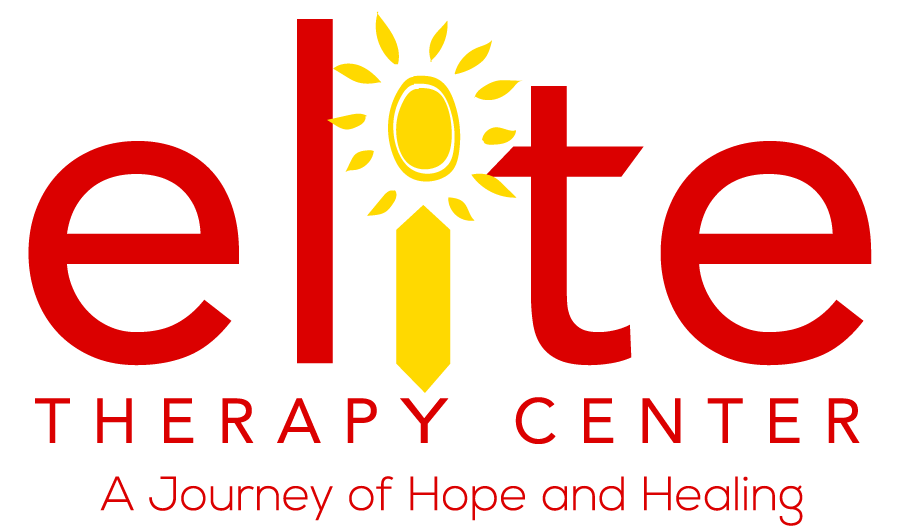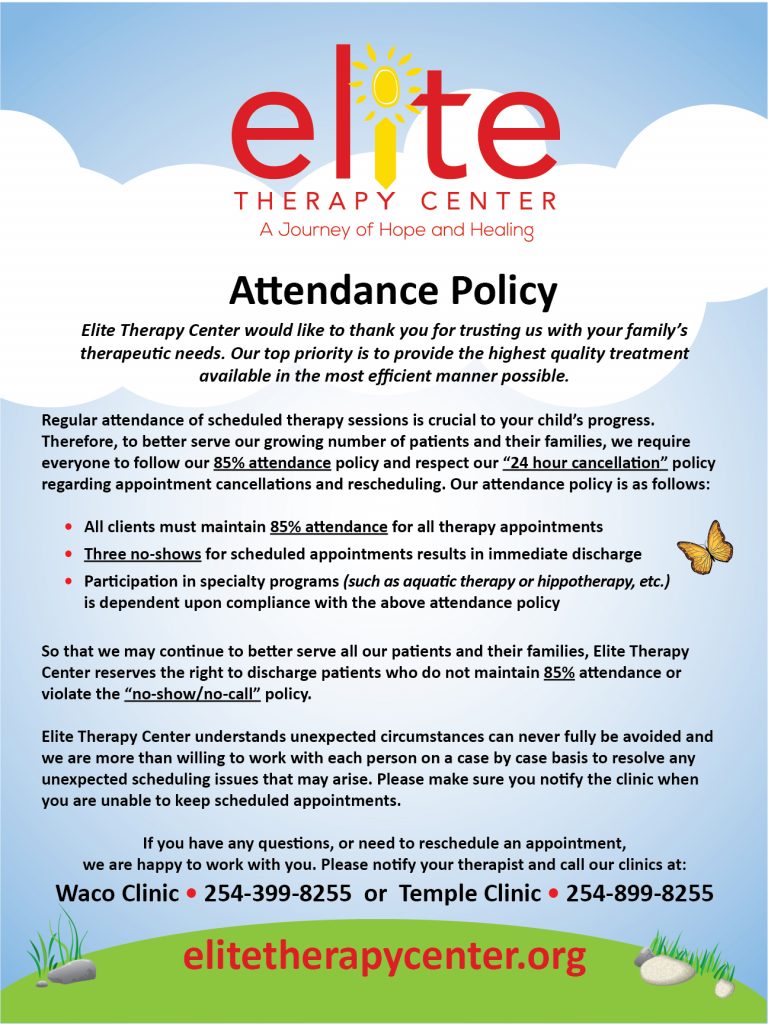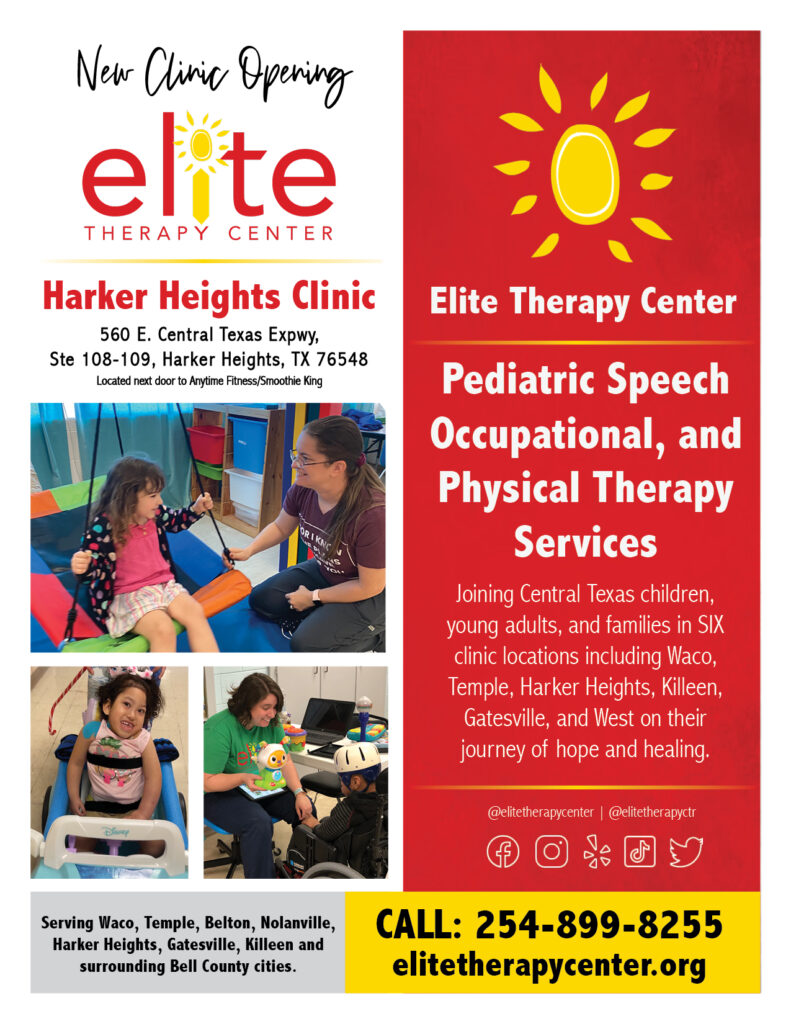Elite Therapy Center’s speech therapy is provided through the Academy for Speech and Language. Owned and operated by ASHA certified Speech-Language Pathologists, our primary objective is to provide quality, comprehensive speech-language therapy to the public. We offer encouragement and celebrate in each client’s success. Remember: Early detection and intervention are key. If you have any concerns, please contact us.
Speech Milestones
0 to 3 Months:
- Listens to speech
- Awakens to loud sounds
- Ceases activity at a new sound
- Makes pleasure sound
- Startles to a sudden sound
- Turns to locate the source of a sound
- Recognizes familiar voices
- Looks at you with interest when you are talking
- Repeats the same sounds
- Cries differently for different needs
4 TO 6 Months:
- Responds to “No” and to changes in tone of voice
- Notices new sounds
- Pays attention to music
- Babbling sounds are more speech like with many different sounds
- Makes gurgling sounds when left alone or when playing with you
- Makes sounds & smiles in response to your facial expressions & sounds
7 TO 12 Months:
- Recognizes his or her own name
- Enjoys games like peek-a-boo and pat-a-cake
- Recognizes words for common items like “cup,” “milk,” “shoe”
- Imitates speech sounds
- Waves “bye-bye”
- Uses speech or non-crying to get or keep attention
- Babbling has both long and short groups of sounds such as “tata upup bibibibibo”
- Has 1 or 2 words although they may not be clear “bye-bye,” “mama,” “no,” “dada”
1 to 2 Years:
- Points to pictures in a book when named
- Points to a few body parts when asked
- Follows simple commands and understands simple questions such as “Roll the ball,” “Kiss the baby,” “Where are your shoes?”
- Listens to simple stories, songs, & rhymes
- Recognizes pictures of familiar places and objects
- Uses many different consonant sounds at the beginning of words
- Uses pronunciation that is not precise
- Points and gestures to call attention to an event or to show wants
- Says more words every month
- By 18 months, says 10-20 words, including names and uses some 1-2 word questions such as, “Where kitty?” “Go bye-bye.” “What’s that?”
- Puts 2 words together such as “more cookie,” no juice,” “mommy book”
- Hums and may sing simple tunes
2 to 3 Years:
- Understands differences in meaning such as, “go-stop,” “in-on,” “up-down”
- Notices sounds
- Follows 2 step requests such as, “Get the book and put it on the table.”
- Demonstrates rapid speech sound development
- Has a word for almost everything
- Uses 2-3 word sentences to talk about and ask for things
- Speech is understood by familiar listeners most of the time
- Tends to simplify difficult words such as “nana” for banana
- Carries on conversation with self and dolls
- Asks questions
- Sentence length is 2-3 words
- Refers to self by name
- Uses personal pronouns (I, you, he)
- Forms some plurals by adding “s”
3 to 4 Years:
- Understands simple “who,” “what,” and “where” questions
- Knows night and day
- Begins to understand prepositional phrases “put the block under the chair”
- Frequently practices talking to himself
- Knows his/her last name, sex, name of the street he/she lives on, and several nursery rhymes
- Can tell a story or relay an idea to someone
- Has a sentence length of 3-4 words
- Has a vocabulary of nearly 1000 words
- Can consistently produce the following sounds: “m, n, ng, p, f, h, and w”
- May repeat sounds, words, and phrases
- Can sing songs
4 to 5 Years:
- Pays attention to a short story & answers questions about it
- Hears and understands most of what is said at home & school
- Points to colors red, blue, yellow, and green
- Understands time concepts
- Can speak of imaginary conditions such as “pretend like” and “I hope”
- Asks many questions, although more interested in how answers fit his/her own thoughts rather than the explanation
- Has a sentence length of 4 to 5 words
- Asks “who” and “why”
- Uses contractions such as “it’s a” and “there’s a”
- Uses past tense correctly
- Has a vocabulary of 1500 words
- Can consistently produce the following sounds: “m, n, ng, p, f, h, w, y, k, b, d, g, r”
5 TO 6 Years:
- Defines objects by their use (You wash with soap.)
- Knows spatial relations like “on top,” “behind,” “far,” and “near”
- Knows his address
- Identifies a penny, nickel, or dime
- Has a sentence length of 5-6 words
- Has a vocabulary of around 2000 words
- Uses all speech sounds correctly with the possible exception of the following: “t, v, l, th, j, and z”
- Knows common opposites
- Counts 10 objects
- Questions for information
- Uses all types of sentences, some of which may be complex
6 Years:
- Has correct articulation of speech sounds
- Uses adult-like grammar in sentences & conversations
- Understands the meaning of most utterances
- Names the day of the week in order and counts to 30
- Predicts the next sequences of events and tells a 4-5 part story
- Knows birthday, name, address
- Knows the meaning of today, yesterday, and tomorrow
- Asks “why, “what,” and “how” often
* Children learn through play, imitation, gestures, reading, and storytelling!
Motor MilestonesEnglish Developmental Sound Chart
Click here for a chart indicating speech milestones for your child.
Adapted information from: American Speech Language Hearing Association www.asha.org, Beyond Words www.beyondwords.org , First Words Project http://firstwords/fsu.edu , & Caroline Bowen , SLP http://members.tripod.com/Caroline_Bowen , Assessment in Speech-Language Pathology, 2 nd ED, Shipley & McAfee, 1998., “It Takes Two to Talk.”
Smith, A.B., L. Hand, J.J. Freilinger, J.E. Bernthal and A. Bird. “The Iowa Articulation Norms Project and its Nebraska Replication,” Journal of Speech and Hearing Disorders,
Vol. 55, No. 4 (November 1990) pp. 779-798.
Created by Claudia Dunaway for San Diego City Schools


